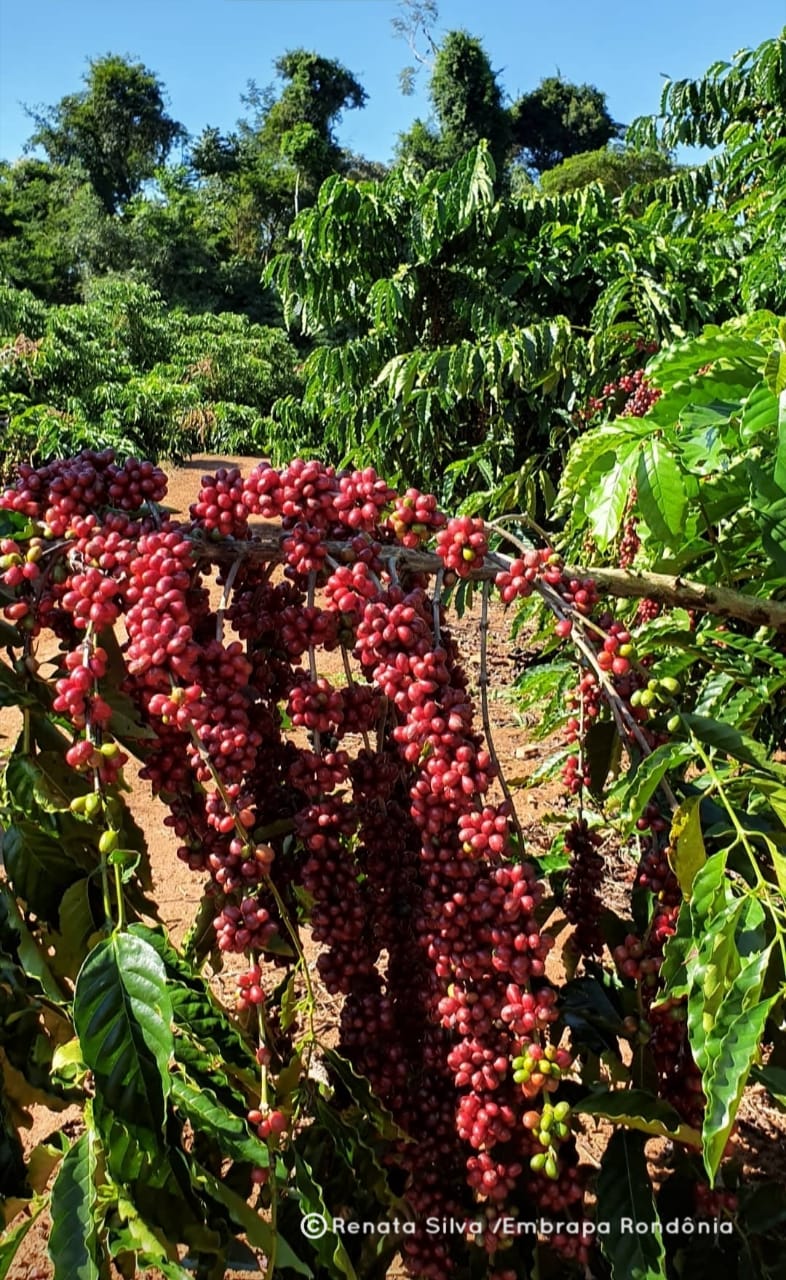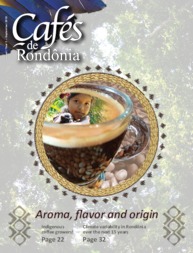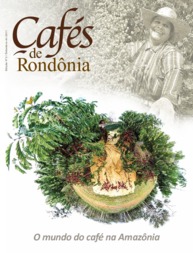Article - People who love forests consume sustainable coffee
Article - People who love forests consume sustainable coffee
Brazil has some of the most emblematic coffee growing in the world, and targeted consumption may be a way towards environmental engagement
*Enrique Alves
Researcher from Embrapa Rondônia, Brazil.
We live in a period when information gets to us from different platforms and media, and that is very good. But this popularization of knowledge has also brought up something as lethal as misinformation: bad information. When such bad pieces of news have to do with important themes such as forest preservation, one should be even more careful.
This is what we are going to talk about: the complex relationship between agriculture and forest. One should not be naive and say that food production in the world has not been based on deforestation. This has always been a fact and all over the world, where agriculture frontiers are concerned, this can still be observed. Nevertheless, something must be clear: there is a great difference between sustainable food production and environmental degradation. Brazil is very rich in good and bad examples, and it is necessary not to generalize in order to avoid creating prejudice and unfair judgment.
Embrapa has advocated that agriculture must have a sustainable perspective and has constantly pursued new technologies aiming at that, in partnership with other institutions. In this context, there is a new model of integrated agricultural production, which has become more and more popular in the country, encompassing several combinations of agricultural, livestock and forest components.
As a result, we have different integrated systems, such as crop-livestock-forestry (ICLFS), crop-livestock (ICLS), silvopastoral (SPS) or agroforestry (AFS) systems. Currently, there are 15 million hectares in the country where different formats of ICLFS strategy are used and we estimate that, for the next 10 years, there will be more than 42 million.
While in the past agriculture went hand in hand with environmental degradation and deforestation, this reality is no longer true for many of the main food crops in the world, and especially with regard to coffee.
One can say that this grain that has built cities and that it is the most consumed beverage in the world after water; it can represent a vital tool for social inclusion and development, quality of life and environmental conservation in Brazil, especially in the Amazon region. This is not a dream, it is a reality.
The adoption of technologies is the path for sustainability
In the current 2020 harvest year, the expected coffee production in Brazil is 60 million 60-Kg bags, harvested from 1.8 million hectares. But in order to demonstrate the evolution of coffee growing in the last decades, two low production harvests (negative two-year period) will be compared, 2001 and 2019.
In 2001, Brazil had 2.6 million hectares of planted coffee – 2.2 million in production and 400,000 in formation – which produced 31 million bags. For the 2019 harvest, the production was 49 million bags, cultivated in 2.1 million hectares – 1.8 million in production and 319,000 in formation.
By observing the graphic of historical pattern of coffee production in Brazil – data provided by the Companhia Nacional de Abastecimento (The National Supply Company) - Conab, one can notice that between the years 2001 and 2019 there was a decrease of 19% in cultivated area, about 500,000 hectares less. But contrary to what would be expected, the grain production increased 58% during the period.
This higher crop yield was mostly motivated by the incorporation of new technologies in the field, which made the average productivity in the areas rise from 14 to 27 bags per hectare - a 93% increase.
Furthermore, despite constant renovation in the crops, in an average rate above 6% per year, this did not entail an increase in cultivated area throughout the last two decades. This proved that areas in formation were mostly replacing obsolete plantations with more technological ones.
Among the new technologies incorporated in coffee growing, we can mention: genetic breeding and selection, irrigation management, efficient spatial management, soil conservation, and integrated management of pests and diseases. All of this made Brazilian crops more sustainable and efficient.
The numbers presented in the graph below show that the evolution of coffee growing in Brazil has nothing to do with deforestation. The country has strengthened its position as a “coffee nation” responsible for about a third of the world’s production.
Coffee growing in the Amazon Region
Brazil is one of the main players in the world's coffee production chain. It is the largest producer and exporter and the second largest consumer in the world. Coffee crops are plural and diversified. There is a true sensorial pallete, reproduced in scents and flavors originated from growing arabica and canefora species (conilon and robusta), cultivated from North to South in the country. A great example of this is present in one of the most emblematic regions in the world: the Amazon region.
In order to illustrate what happens with coffee production in this region we are going to talk about the state of Rondônia, which, according to the Instituto Brasileiro de Geografia e Estatística (Brazilian Institute of Geography and Statistics) – IBGE, is responsible for 97% of all the coffee produced in the Amazon region. This state is the fifth largest coffee producer in the country and the second producer of the canefora species. While coffee growing in Brazil has evolved as a whole, the leap in the production chain in the state of Rondônia was quantic.
Coffee in the Amazon region is not something recent. According to historical reports, the first coffee crop in Brazil was cultivated in Northern lands, in the Pará state, in 1727. Afterwards it was taken to the Southeast region of the country, which was more developed at that time, and it took the shape we know today. Coffee only started to have economic importance for the Amazon region again in the 1970s with the pioneers who came to explore the region. They came especially from the states of Espírito Santo, Paraná and Minas Gerais.
It was a period of great territorial expansion of the crop in the North of the country. However, the coffee that was produced there was considered low quality and the plants, not very productive; a result of agricultural activities that bordered on forest extraction and low efficiency in the use of the land.
As it happened in the whole country, coffee farming in the Amazon region grew. In 2001, Rondônia state already counted on 318,000 hectares of the crop – 245,000 in production and 73,000 in formation – which produced 1.9 million bags and still kept a low-technology pattern, with an average yield of eight bags per hectare.
Currently the expected production for the 2020 harvest is over 2.3 million bags, produced in a planted area that is 78% smaller than in 2001, and with 71,000 hectares, of which 65,000 are in production and 6,000 in formation. In almost two decades, the productivity evolved to 36 bags per hectare, thanks to the growers who, as each year passes by, dedicate themselves more and more to the use of technologies based on sustainability.
If Brazil has done its homework in the last few years, the coffee growers in the Amazon Region have been taking extra credits. If there is a region in the terrestrial globe where it is possible to rapidly increase its coffee production without one single hectare of deforestation, this place is located in the state of Rondônia.
In simple calculations, if we returned to the status of cultivated area in 2001 and the current productivity, the state would produce more than 11 million bags of coffee. The answer for an increasing world demand for coffee production may indeed find its place in the Amazon Region. See this incredible evolution in the last years in the graph below.
“Green forest trade” for Amazonian coffees
Having said that, it becomes clear that the recurrent argument of the link between the coffee production and deforestation does not hold. Not only has coffee farming reduced the area used for cultivation, but it has also made it more efficient and productive. And I dare say that people who love forests should consume more Brazilian coffee – especially the ones from the Amazon Region. The world coffee market already values fair trade and could start paying a “green forest trade” value for Amazonian coffee with ecological bias.
Coffee growing can genuinely be sustainable and an ally for forest preservation. Since it presents a high economic yield per hectare when compared to other more extensive ones, it can sustain the life quality of coffee growers and their families in small rural units. This represents less pressure on the forest and makes such farmers less prone to start environmentally predatory practices.
In the state of Rondônia alone, coffee growers form a real army of more than 17,000 families who have coffee as their main source of income. These farmers comprise almost one fifth of all the rural establishments in the state. Keeping the economic viability of these families in the field should be a goal for the whole coffee production chain as well as for the people who worry about the forests in Brazil – especially in the Amazon Region.
More quality, inclusion and recognition
A demonstration of the evolution of coffee growing in the Amazon region is that it has started the process of becoming the first Geographical Indication of sustainable canefora coffee in the world. It would consist in the “Região Matas de Rondônia”, which produces Amazon Robustas, and is responsible for approximately 80% of all the coffee produced in the Amazon Region.
In addition, preserving a forest has never been so pleasant. The Robustas of the Amazon, whose unique eccentricity and sensorial characteristics have conquered the attention of refined coffee consumers in Brazil and all over the world, are the theme for the largest contest of the species in Brazil, “Concafé”: besides awarding the best coffees produced in the state every year, it also awards the most sustainable ones. It is not only about producing in quantity and quality; the evolution of the chain also needs to make sure the environment is preserved for the next generations.
In the Amazon Region, coffee also supports something that sometimes is completely forgotten in the conservation and sustainability discourse: the human factor. Dwellers of this region depend on environmental resources to survive and they need to look for ways to live in harmony with the environment.
The state of Rondônia has given a good example. Social initiatives are happening organically and naturally along the production chain. Amazonian coffee growing has never been so diversified and inclusive. Women, youngsters and the Indigenous population are essential and they drive the cultivation. The International Coffee Alliance - IWCA in Brazil has one of its most beautiful chapters in the state of Rondônia.
The protagonism of the original peoples who inhabited Brazilian forests before any pioneer is also an accomplishment of Amazonian coffee growing. The Indigenous people who have cultivated coffee in their lands for over 30 years have just begun to see in the production of fine Robustas a sustainable means to obtain financial resources in the forest.
Although this may seem revolutionary, it shouldn’t be something that extraordinary. Doesn’t coffee have its origin in the glades and edges of African forests? Then it would be a sort of rescue. The coffee from the Amazon Region is, above all, a fusion of scents and flavors – a great blend of tradition, technology and origin.
Preserving the Amazon Forest means keeping our ability of taking anyone’s breath away when faced with the beauty and riches that were once discovered and later hidden in such an important and emblematic region.
-------------------------------
*Enrique Anastácio Alves has a PhD in Agricultural Engineering and since 2010 he has worked as a researcher at the Brazilian Agricultural Research Corporation- Embrapa, in the areas of coffee harvest, post-harvest and beverage quality. Contact: enrique.alves@embrapa.br.
English version proofread and edited by Mariana Medeiros on July 07, 2020.
Who love forests consume sustainable coffee
Embrapa Rondônia
Press inquiries
rondonia.imprensa@embrapa.br
Phone number: +55 69 3219-5011
Mariana Medeiros (revisão - inglês)
Secretaria Geral
Further information on the topic
Citizen Attention Service (SAC)
www.embrapa.br/contact-us/sac/



